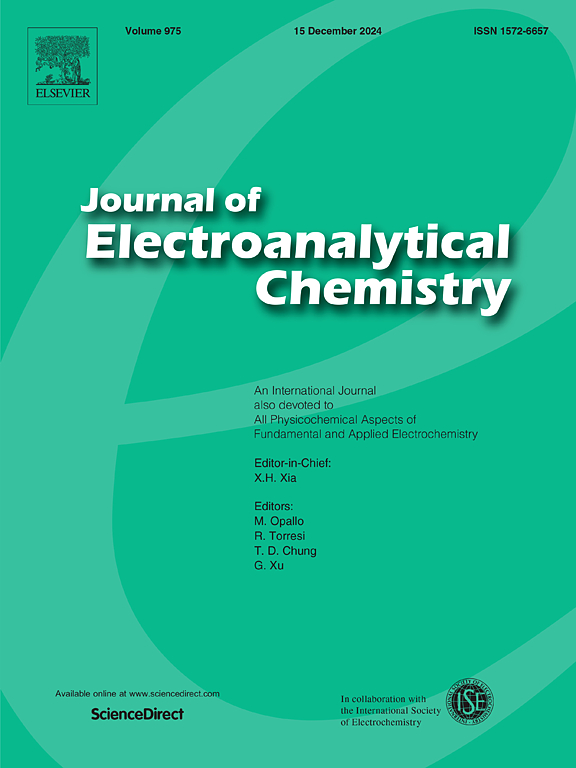通过在MnOx/WO3上诱导孔积累提高微量H2O2的光电化学检测精度
IF 4.1
3区 化学
Q1 CHEMISTRY, ANALYTICAL
引用次数: 0
摘要
阳极光电化学(APEC)方法对痕量过氧化氢(H2O2)的检测灵敏度和检测极限受到孔洞缓慢迁移动力学的限制,难以满足当前化工行业的要求。为此,提出了界面孔富集工程来解决这一难题。随后,锰氧化物(MnOx)被光沉积在三氧化钨(WO3)上,作为概念验证原型光阳极。光电结构表征表明,MnOx可以通过增加光生成孔的浓度和寿命来降低H2O2氧化过电位,从而显著加速H2O2氧化。结果表明,MnOx/WO3光阳极对H2O2的检测限低至0.1 mM,灵敏度为4.81 μA cm−2mm−1,分别是WO3光阳极的0.125 (0.8 mM)和1.72 (2.79 μA cm−2mm−1)倍。这项工作证明了一种孔富集策略,以提高痕量H2O2分析的灵敏度。本文章由计算机程序翻译,如有差异,请以英文原文为准。

Boosting photoelectrochemical detection accuracy of trace H2O2 by inducing holes accumulation on the MnOx/WO3
Restrained by sluggish migration dynamics of holes, the detection sensitivity and limit of an anodic photoelectrochemical (APEC) strategy for trace hydrogen peroxide (H2O2) is generally difficult to meet the demands of the current chemical industry. Herein, interface hole enrichment engineering is proposed to solve this challenge. Subsequently, manganese oxide species (MnOx) was photo-deposited on tungsten trioxide (WO3) as a proof-of-concept prototype photoanode. Photoelectric structure characterization demonstrated that MnOx species were validated to diminish H2O2 oxidation overpotential by increasing the concentration and lifetime of photogenerated holes, accelerating significantly H2O2 oxidation. As a result, the MnOx/WO3 photoanode achieves a lower detection limit of 0.1 mM and a higher sensitivity of 4.81 μA cm−2 mM−1 for H2O2 detection respectively, which are 0.125 (0.8 mM) and 1.72 (2.79 μA cm−2 mM−1) times sensitive compared to that of WO3 photoanode. This work demonstrates a hole enrichment strategy to boost the sensitivity of trace H2O2 analysis.
求助全文
通过发布文献求助,成功后即可免费获取论文全文。
去求助
来源期刊
CiteScore
7.80
自引率
6.70%
发文量
912
审稿时长
2.4 months
期刊介绍:
The Journal of Electroanalytical Chemistry is the foremost international journal devoted to the interdisciplinary subject of electrochemistry in all its aspects, theoretical as well as applied.
Electrochemistry is a wide ranging area that is in a state of continuous evolution. Rather than compiling a long list of topics covered by the Journal, the editors would like to draw particular attention to the key issues of novelty, topicality and quality. Papers should present new and interesting electrochemical science in a way that is accessible to the reader. The presentation and discussion should be at a level that is consistent with the international status of the Journal. Reports describing the application of well-established techniques to problems that are essentially technical will not be accepted. Similarly, papers that report observations but fail to provide adequate interpretation will be rejected by the Editors. Papers dealing with technical electrochemistry should be submitted to other specialist journals unless the authors can show that their work provides substantially new insights into electrochemical processes.

 求助内容:
求助内容: 应助结果提醒方式:
应助结果提醒方式:


